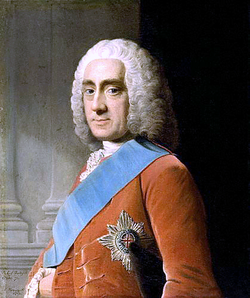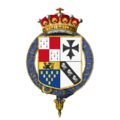Philip Stanhope, 4th Earl of Chesterfield
Philip Dormer Stanhope, 4th Earl of Chesterfield PC KG (22 September 1694 – 24 March 1773) was a British statesman and intellectual.
Stanhope was born in London. He got his schooling at Trinity Hall, Cambridge.[1] After that, he went on the Grand Tour of the continent. He became gentleman of the bedchamber to the Prince of Wales.
Career in government
In 1715, he entered the House of Commons as Lord Stanhope of Shelford and member for St Germans. He left for Paris and sent the government valuable information about the Jacobite plot. In 1716, he returned to Britain and sat in the House of Commons. He liked to take part in the debates.
He took his seat in the House of Lords. In 1728, he was sent to the Hague as ambassador. He did a good job, and got the Order of the Garter in 1730, and the position of Lord Steward. After he did not support Walpole's Excise Bill, he was dismissed from his stewardship. He spent years opposing the ruling party in the House of Lords. First against Robert Walpole and then against King George II of England. In 1744, the "Broad Bottom" party, led by Chesterfield and Pitt, came into office. They ruled together with the Pelhams.
He was then sent to the Hague as ambassador a second time. The object of his mission was to persuade the Dutch to join in the War of the Austrian Succession. His mission was successful. When he got back to London, he was made Lord-Lieutenancy of Ireland. This was a position he wanted for a long time.
He took the his role seriously. He established schools and manufacturing in Ireland. In politics, he found a way to work with both Protestant and Roman Catholic parties.
He also still took his seat in the Upper House. In 1751, he helped in making the Gregorian calendar a fact. That Act of Parliament is sometimes known as Chesterfield's Act. After he slowly became deaf, he had to stop his work in the parliament.
He lived for some years at the Ranger's House, Chesterfield Walk, Greenwich, London.
How he is remembered
In politics, he is best known for the time he was Lord Lieutenant of Ireland. As a writer, he is best known for his Letters to his Son. Those letters were not really written to be read by the general public. His widow Eugenia Stanhope first published them in 1774. Letters to his Godson was published in 1890. Both sets of letters are written with great style and knowledge.
Chesterfield County, Virginia and Chesterfield County, South Carolina in the United States were named in his honour. He also plays a role in the 1757-1758 novel The Virginians by William Makepeace Thackery.
Things he has probably said:
- "An able man shows his spirit by gentle words and resolute actions."
- "I recommend you to take care of the minutes, for the hours will take care of themselves."
Philip Stanhope, 4th Earl Of Chesterfield Media
Philip Stanhope by Roubiliac, 1745, Victoria and Albert Museum
Chesterfield's "Phoenix Monument" (1746) in Phoenix Park, Dublin
Philip Dormer Stanhope, 4th Earl of Chesterfield by William Hoare
Other websites
- Works by Philip Stanhope, 4th Earl of Chesterfield at Project Gutenberg
- Scans of Stanhope's Letters to his son, 1774–1775 edition, Vol. 1, Vol. 2
- Guide to the Chesterfield Manuscripts at the Lilly Library, Indiana University
References
- ↑ Stanhope, Philip Dormer in Venn, J. & J. A., Alumni Cantabrigienses, Cambridge University Press, 10 vols, 1922–1958.
| This article includes text from the public domain 1911 Encyclopaedia Britannica. Please add to the article as needed. |
| Parliament of Great Britain (1707–1800) | ||
|---|---|---|
| Preceded by John Knight Waller Bacon |
Member of Parliament for St Germans with John Knight 1715–1722 |
Succeeded by Lord Binning Philip Cavendish |
| Preceded by Marquess of Hartington John Newsham |
Member of Parliament for Lostwithiel with Marquess of Hartington 1722–1724 |
Succeeded by Sir Orlando Bridgeman Henry Parsons |
| Political offices | ||
| Preceded by The Earl of Derby |
Captain of the Yeomen of the Guard 1723–1725 |
Succeeded by The Earl of Leicester |
| Preceded by The Duke of Dorset |
Lord Steward 1730–1733 |
Succeeded by The Duke of Devonshire |
| Preceded by The Duke of Devonshire |
Lord Lieutenant of Ireland 1745–1746 |
Succeeded by The Earl of Harrington |
| Preceded by The Earl of Harrington |
Northern Secretary 1746–1748 |
Succeeded by The Duke of Newcastle |
| Peerage of England | ||
| Preceded by Philip Stanhope |
Earl of Chesterfield 1726–1773 |
Succeeded by Philip Stanhope |





